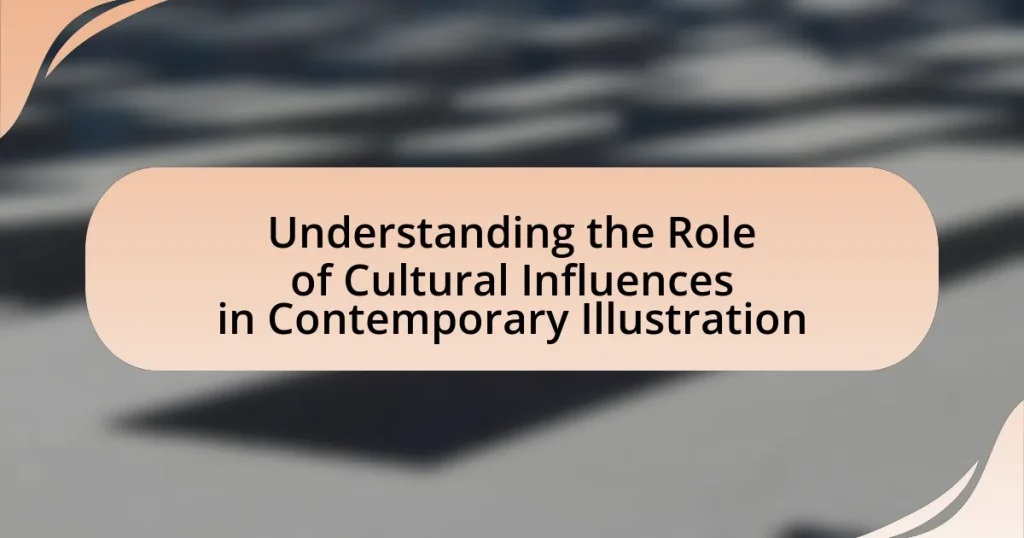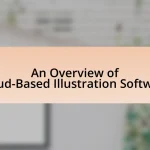The article explores the significant role of cultural influences in contemporary illustration, highlighting how diverse social, historical, and artistic contexts shape visual narratives. It examines the impact of globalization and technology on the blending of styles and themes, as well as the importance of cultural narratives in storytelling and audience interpretation. Key trends, such as the integration of traditional motifs and the reflection of social movements, are discussed alongside best practices for illustrators to ensure respectful representation of diverse cultures. The article emphasizes the necessity of cultural understanding for effective visual communication and the challenges of maintaining authenticity in a globalized world.
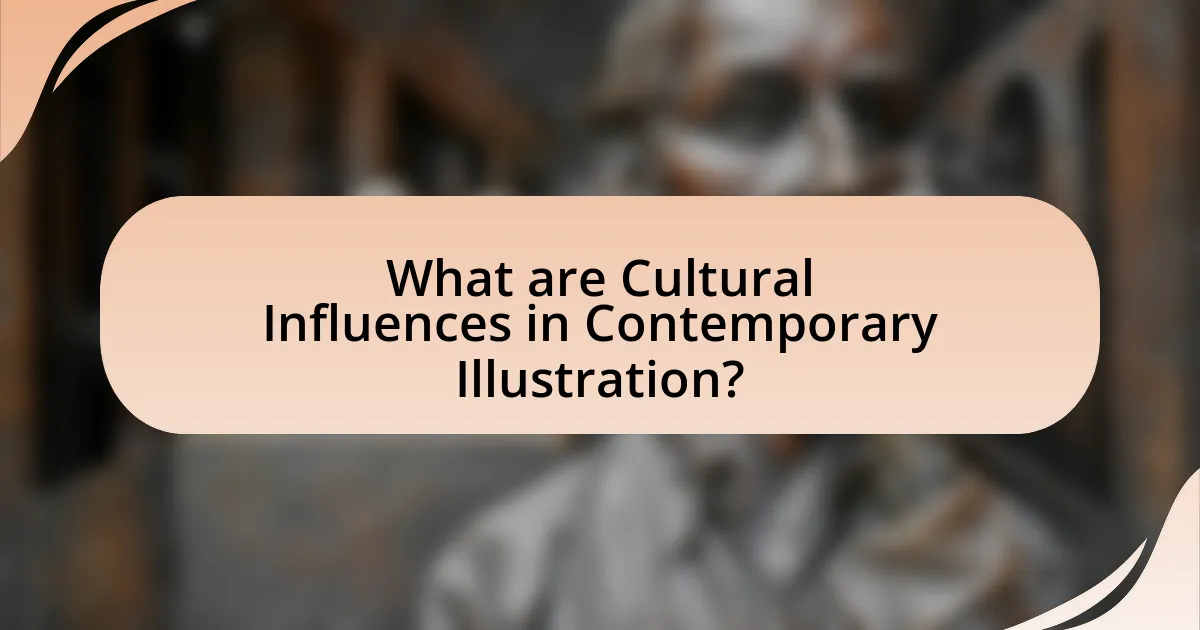
What are Cultural Influences in Contemporary Illustration?
Cultural influences in contemporary illustration encompass the diverse social, historical, and artistic contexts that shape visual narratives. These influences include globalization, which allows for the blending of styles and themes from various cultures, as seen in the incorporation of traditional motifs into modern designs. Additionally, social movements, such as feminism and environmentalism, significantly impact the subject matter and messaging in illustrations, reflecting current societal values and issues. For instance, the rise of digital platforms has enabled artists to reach global audiences, further diversifying the cultural references present in their work.
How do cultural influences shape the themes in contemporary illustration?
Cultural influences shape the themes in contemporary illustration by reflecting societal values, traditions, and narratives that resonate with diverse audiences. Illustrators often draw inspiration from their cultural backgrounds, leading to the incorporation of specific symbols, color palettes, and storytelling techniques that convey cultural identity. For instance, the use of indigenous motifs in illustrations can highlight the importance of heritage and community, while contemporary social issues, such as gender equality and environmentalism, are often depicted through culturally relevant lenses. This interplay between culture and illustration not only enriches the visual narrative but also fosters a deeper connection with viewers, as seen in the works of artists like Yuko Shimizu, who blends Japanese aesthetics with modern themes.
What specific cultural elements are commonly represented in illustrations?
Specific cultural elements commonly represented in illustrations include traditional clothing, architectural styles, symbols, and folklore. Traditional clothing reflects the identity and heritage of a culture, such as the kimono in Japanese illustrations or the sari in Indian art. Architectural styles, like the pagoda or adobe structures, signify cultural backgrounds and historical contexts. Symbols, such as the yin-yang in Chinese culture or the dreamcatcher in Native American traditions, convey deeper meanings and beliefs. Folklore elements, including mythological creatures and stories, are often depicted to celebrate cultural narratives and values. These representations serve to communicate cultural identity and heritage visually, making them integral to the understanding of contemporary illustration.
How do cultural narratives impact the storytelling in illustrations?
Cultural narratives significantly shape storytelling in illustrations by providing context, themes, and symbols that resonate with specific audiences. These narratives influence the visual language used by illustrators, guiding the choice of colors, characters, and settings that reflect cultural values and beliefs. For example, illustrations in children’s literature often incorporate cultural folklore, which not only entertains but also imparts moral lessons relevant to that culture. Research by the American Psychological Association indicates that culturally relevant illustrations enhance comprehension and engagement, demonstrating that illustrations rooted in cultural narratives can effectively communicate complex ideas and emotions.
Why is it important to understand cultural influences in illustration?
Understanding cultural influences in illustration is crucial because it shapes the effectiveness and relevance of visual communication. Illustrators who grasp these influences can create work that resonates with diverse audiences, ensuring that their messages are culturally sensitive and appropriate. For instance, research by the American Psychological Association indicates that culturally informed illustrations can enhance viewer engagement and comprehension, as they reflect the values and experiences of specific communities. This understanding not only fosters inclusivity but also enriches the narrative depth of the artwork, making it more impactful and relatable.
What role does cultural context play in audience interpretation?
Cultural context significantly influences audience interpretation by shaping the meanings and associations individuals derive from visual content. This influence manifests through shared values, beliefs, and experiences that vary across different cultures, affecting how illustrations are perceived. For instance, a study by Hall (1976) on high-context and low-context cultures illustrates that individuals from high-context cultures rely more on implicit messages and non-verbal cues, while those from low-context cultures focus on explicit information. This distinction highlights how cultural background can lead to divergent interpretations of the same illustration, underscoring the necessity for creators to consider cultural nuances in their work.
How can cultural understanding enhance the effectiveness of illustrations?
Cultural understanding enhances the effectiveness of illustrations by ensuring that visual representations resonate with the intended audience’s values, beliefs, and experiences. When illustrators are aware of cultural nuances, they can create imagery that reflects the audience’s identity, leading to greater emotional engagement and comprehension. For instance, research by the American Psychological Association indicates that culturally relevant visuals can improve recall and understanding by up to 50% in educational contexts. This demonstrates that illustrations that align with cultural contexts not only communicate messages more effectively but also foster a deeper connection between the viewer and the content.
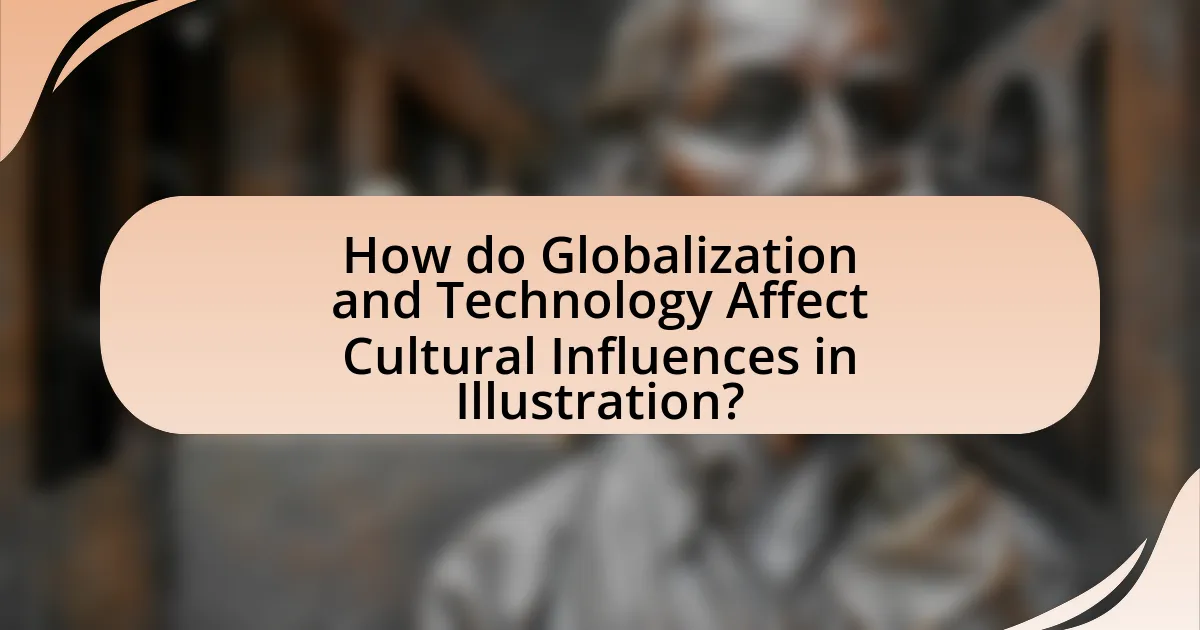
How do Globalization and Technology Affect Cultural Influences in Illustration?
Globalization and technology significantly shape cultural influences in illustration by facilitating the exchange of diverse artistic styles and ideas across borders. Globalization allows illustrators to access a wider audience and collaborate with artists from different cultures, leading to a fusion of techniques and themes that reflect a more interconnected world. For instance, the rise of social media platforms enables artists to share their work globally, drawing inspiration from various cultural backgrounds, which can be seen in the increasing popularity of hybrid styles that blend traditional and contemporary elements. Additionally, technology, such as digital illustration tools and software, empowers artists to experiment with new forms and techniques, further diversifying the visual language in illustration. This interplay between globalization and technology not only enriches the artistic landscape but also promotes cultural dialogue and understanding, as evidenced by the growing presence of multicultural narratives in contemporary illustration.
What impact does globalization have on contemporary illustration styles?
Globalization significantly influences contemporary illustration styles by facilitating the exchange of diverse cultural elements and artistic techniques across borders. This cross-cultural interaction leads to the blending of traditional and modern styles, resulting in unique hybrid forms of illustration. For instance, the incorporation of Eastern aesthetics into Western graphic design has become increasingly prevalent, as seen in the works of illustrators like Yuko Shimizu, who merges Japanese influences with contemporary themes. Furthermore, globalization enables artists to access a wider audience through digital platforms, allowing for the rapid dissemination of various styles and trends, which in turn shapes the evolution of illustration practices worldwide.
How do cross-cultural exchanges influence artistic techniques?
Cross-cultural exchanges significantly influence artistic techniques by facilitating the sharing and blending of diverse styles, materials, and concepts. For instance, the introduction of Japanese woodblock printing techniques in Europe during the 19th century led to the Impressionist movement, where artists like Vincent van Gogh incorporated these methods into their work, resulting in a unique fusion of Eastern and Western aesthetics. This blending not only enriched individual artistic practices but also expanded the overall scope of contemporary illustration, allowing for innovative approaches that reflect a globalized perspective.
What are the challenges of maintaining cultural authenticity in a globalized world?
Maintaining cultural authenticity in a globalized world faces significant challenges, primarily due to the homogenization of cultures and the influence of dominant global narratives. The proliferation of digital media and global communication allows for widespread dissemination of cultural products, often overshadowing local traditions and practices. For instance, the rise of Western pop culture can lead to the dilution of indigenous art forms, as seen in various regions where traditional practices are replaced by more commercially viable, globalized alternatives. Additionally, economic pressures compel local artists to adapt their work to meet global market demands, further compromising authenticity. This dynamic creates a tension between preserving unique cultural identities and engaging with a global audience, making it increasingly difficult to maintain cultural authenticity.
How does technology facilitate cultural exchange in illustration?
Technology facilitates cultural exchange in illustration by providing platforms for artists to share their work globally and access diverse cultural influences. Digital tools, such as social media and online galleries, enable illustrators to showcase their art to a worldwide audience, fostering cross-cultural interactions. For instance, platforms like Instagram and Behance allow artists from different backgrounds to connect, collaborate, and inspire one another, leading to a blend of styles and techniques that reflect various cultural narratives. Additionally, advancements in software and digital art tools empower illustrators to experiment with and incorporate elements from different cultures into their work, enhancing the richness and diversity of contemporary illustration.
What platforms are most effective for sharing culturally influenced illustrations?
Social media platforms such as Instagram, Pinterest, and Behance are most effective for sharing culturally influenced illustrations. Instagram’s visual-centric design allows artists to reach a global audience, with over 1 billion monthly active users, making it ideal for showcasing diverse cultural themes. Pinterest serves as a discovery tool, where users curate boards that often reflect cultural aesthetics, driving engagement and inspiration. Behance, a platform specifically for creative professionals, enables artists to present their portfolios and connect with like-minded individuals, fostering a community that appreciates cultural narratives in art. These platforms collectively enhance visibility and engagement for culturally influenced illustrations.
How do digital tools shape the representation of cultural themes?
Digital tools significantly shape the representation of cultural themes by enabling diverse forms of expression and accessibility. These tools, such as graphic design software, social media platforms, and digital art applications, allow artists to create and share culturally relevant content with a global audience. For instance, the use of Adobe Illustrator and Photoshop facilitates the incorporation of traditional motifs into modern designs, bridging cultural heritage with contemporary aesthetics. Additionally, platforms like Instagram and Pinterest provide artists with the ability to showcase their work, fostering cross-cultural dialogue and collaboration. This democratization of art creation and distribution enhances the visibility of various cultural narratives, as evidenced by the rise of digital art movements that celebrate multiculturalism and challenge dominant cultural paradigms.
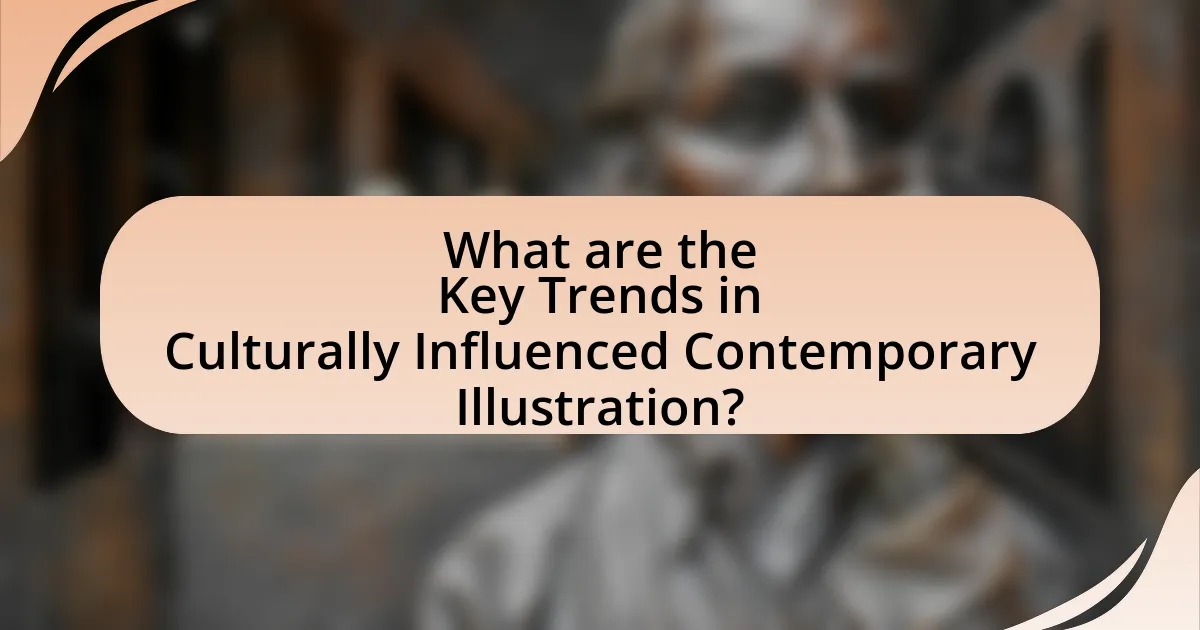
What are the Key Trends in Culturally Influenced Contemporary Illustration?
Key trends in culturally influenced contemporary illustration include the integration of diverse cultural narratives, the use of traditional motifs in modern contexts, and the emphasis on social issues through visual storytelling. Illustrators increasingly draw from their cultural backgrounds to create unique perspectives, as seen in the rise of artists like Yuko Shimizu, who blends Japanese aesthetics with contemporary themes. Additionally, the incorporation of indigenous art styles and techniques into mainstream illustration reflects a growing appreciation for cultural heritage, as evidenced by the popularity of works that celebrate African, Asian, and Latin American influences. This trend is supported by data indicating that consumers are more inclined to engage with art that resonates with their cultural identities, highlighting the importance of representation in the visual arts.
What are the emerging styles in contemporary illustration influenced by culture?
Emerging styles in contemporary illustration influenced by culture include digital collage, minimalism, and cultural fusion. Digital collage combines various visual elements from different sources, reflecting the globalized nature of culture and technology. Minimalism emphasizes simplicity and clarity, often drawing from Eastern philosophies and aesthetics. Cultural fusion blends traditional motifs and techniques from diverse cultures, creating unique visual narratives that resonate with a multicultural audience. These styles are increasingly prevalent as artists seek to express their identities and experiences in a rapidly changing world, showcasing the dynamic interplay between culture and visual art.
How do social movements reflect in contemporary illustration trends?
Social movements significantly influence contemporary illustration trends by inspiring artists to visually communicate social issues and advocate for change. For instance, the Black Lives Matter movement has led to a surge in illustrations that depict themes of racial justice, equality, and empowerment, often utilizing bold colors and powerful imagery to convey urgency and emotion. This trend is supported by the increased visibility of these illustrations on social media platforms, where artists share their work to raise awareness and foster dialogue. Additionally, the rise of environmental movements has prompted illustrators to create works that highlight climate change and sustainability, employing visual metaphors to engage audiences emotionally. The impact of these movements is evident in the way contemporary illustrations serve as both artistic expression and tools for activism, reflecting societal values and concerns.
What role do cultural festivals and events play in shaping illustration trends?
Cultural festivals and events significantly influence illustration trends by providing a platform for artists to showcase their work and engage with diverse audiences. These gatherings often highlight specific themes, styles, and cultural narratives, which can inspire illustrators to adopt or adapt these elements in their creations. For instance, events like Comic-Con or local art fairs expose artists to new ideas and techniques, fostering innovation in their work. Additionally, the visibility of various cultural expressions during these festivals can lead to a broader acceptance and integration of different artistic styles, as seen in the rise of street art and graphic novels influenced by multicultural themes. This dynamic interaction between artists and audiences at cultural events ultimately shapes the evolution of illustration trends, reflecting the changing societal values and interests.
How can artists effectively incorporate cultural influences into their work?
Artists can effectively incorporate cultural influences into their work by engaging deeply with the traditions, symbols, and narratives of the cultures they wish to represent. This engagement can involve studying historical contexts, understanding cultural significance, and collaborating with cultural practitioners to ensure authenticity. For instance, artists like Kehinde Wiley draw on classical portraiture while infusing elements of African American culture, creating a dialogue between different cultural narratives. Research indicates that artists who immerse themselves in cultural studies and community interactions produce work that resonates more profoundly with diverse audiences, as seen in the works of Frida Kahlo, who integrated Mexican folklore and personal identity into her art.
What best practices should illustrators follow when drawing from cultural influences?
Illustrators should prioritize cultural sensitivity and research when drawing from cultural influences. This involves understanding the historical context, significance, and nuances of the culture being represented to avoid misrepresentation or appropriation. For instance, the American Psychological Association emphasizes the importance of cultural competence in creative fields, highlighting that informed representation fosters respect and authenticity. Additionally, collaborating with individuals from the culture can provide valuable insights and ensure accuracy in portrayal. This practice not only enriches the illustrator’s work but also honors the cultural heritage being depicted.
How can illustrators ensure respectful representation of diverse cultures?
Illustrators can ensure respectful representation of diverse cultures by conducting thorough research and engaging with members of those cultures. This approach allows illustrators to understand cultural nuances, traditions, and values, which is essential for accurate representation. For instance, a study published in the Journal of Visual Culture emphasizes the importance of cultural sensitivity and collaboration with cultural representatives to avoid stereotypes and misrepresentation. By prioritizing these practices, illustrators can create work that honors and respects the cultures they depict.
What resources are available for understanding cultural influences in illustration?
Books, academic journals, and online courses are key resources for understanding cultural influences in illustration. Notable books include “Illustration: A Visual History” by John O’Reilly, which explores the evolution of illustration across cultures, and “The Art of Illustration” by David H. Lewis, which discusses cultural contexts in various illustrative styles. Academic journals such as “Illustration” and “Visual Communication” publish peer-reviewed articles that analyze cultural themes in illustration. Online platforms like Coursera and Skillshare offer courses focusing on cultural aspects in art and illustration, providing structured learning opportunities. These resources collectively enhance comprehension of how cultural factors shape illustrative practices.
